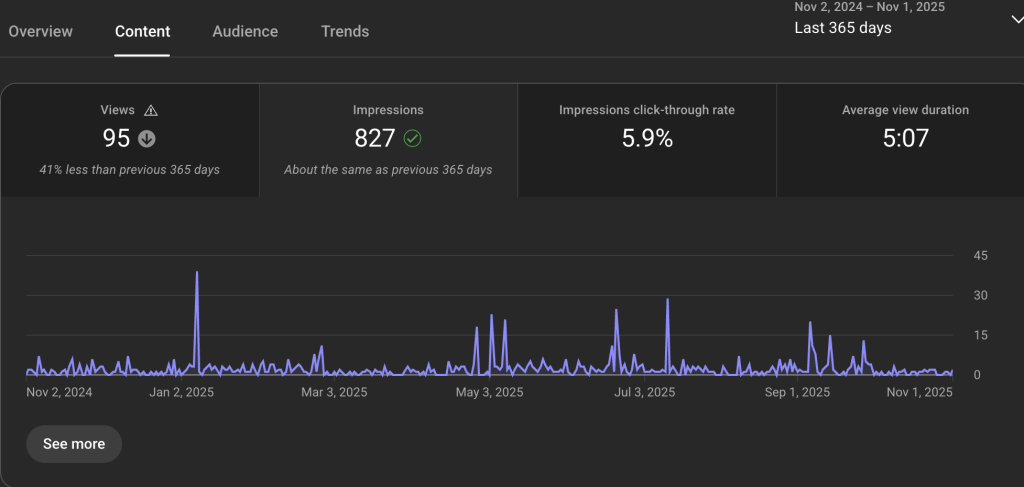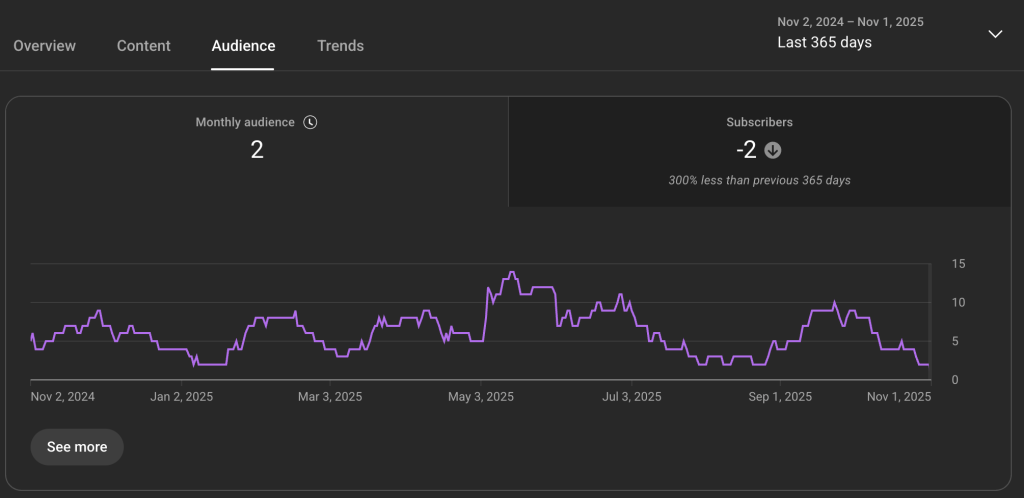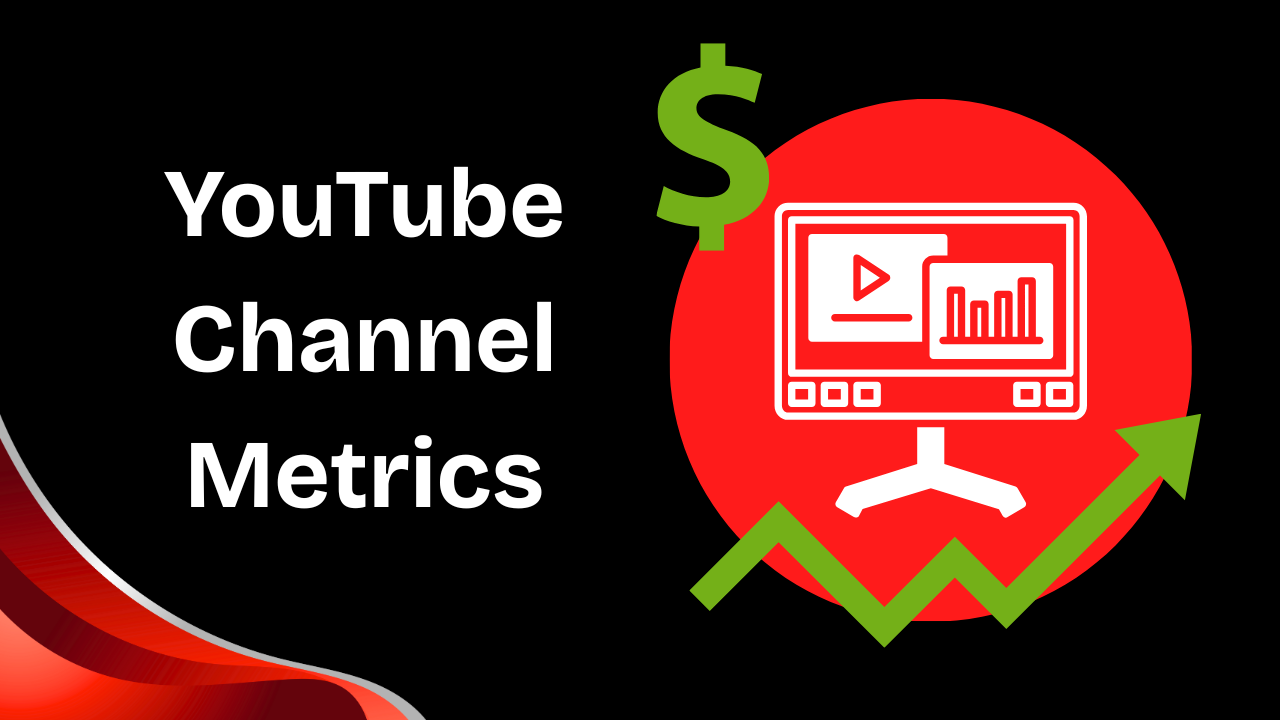Growing on YouTube isn’t just about posting videos and hoping people show up.
If you want real success with more views, more engagement, and more revenue, you need to understand what’s happening behind the scenes.
That’s where YouTube channel metrics come in.
Tracking your analytics can show you what content your audience loves, when they watch, and why they subscribe (or don’t).
And when you use that data to guide your strategy, your channel can grow faster than ever. You’ll have more potential to monetize YouTube then.
In this guide, you’ll learn exactly which YouTube metrics matter most, why they’re important, and what they tell you about your channel’s performance.
Table of Contents
What Are YouTube Channel Metrics?

YouTube channel metrics are the performance data and insights that YouTube collects about your videos, viewers, and overall channel activity.
You can have a better idea then about how to rank your videos on YouTube with more success.
These metrics are populated inside YouTube Studio > Analytics, and they help you understand exactly how your content is performing over time.
Think of them as the “health check” for your channel. They show things like how many people are watching your videos, how long they stay engaged, comments and subscribe rates, how they found you, and audience demographics, to name a few.
The great thing about these metrics is that they remove the guesswork. Instead of hoping a video does well, you can look at real data to see what’s working and what needs improvement.
YouTube channel metrics mainly fall into four major categories:
- Engagement: How viewers interact (likes, comments, shares, watch time)
- Viewer Insights: Who is watching and how they behave (CTR, demographics)
- Reach: How many people discover your channel (impressions, unique viewers)
- Overall Channel Growth: Subscribers and top-performing content
As we review the 12 important YouTube channel metrics in this article, we will categorize them into these four areas.
Also know that any creator from business to entertainment can use these metrics to make better decisions.
When you track YouTube channel metrics regularly, you learn key information such as:
- Which topics your audience loves most
- What causes viewers to click away or stay longer
- How to create videos that convert viewers into subscribers
- Where your best traffic sources are coming from
- How to boost views, retention, and revenue at the same time
In short, YouTube channel metrics are your roadmap to faster growth.

If you want to monetize YouTube sooner, get more recommended placements, and build a loyal audience, these metrics will guide every high-impact move you make.
You can also track YouTube shorts analytics there, but we will only focus on regular YouTube video metrics in this article.
What Do YouTube Channel Metrics Mean to Your Channel?
YouTube channel metrics give you a deeper understanding of how your content performs and how your audience responds to it. This is important on TikTok and other social media platforms as well.
nstead of creating videos blindly, these insights show you what actually moves your channel forward.
Each metric tells a part of the story with things like whether your titles attract attention, your videos hold interest, or your content inspires viewers to interact and come back for more.
There are many takeaways you can gain from reviewing YouTube channel metrics.
When you analyze these metrics consistently, you can make smarter decisions. For example, if you notice your watch time is increasing, it suggests that your videos are keeping viewers engaged longer.
If your click-through rate jumps after updating your thumbnails, you know your packaging is improving. Metrics help turn these observations into practical strategies that lead to growth.
For creators and businesses focused on monetization, metrics are even more important.
YouTube watch time and returning viewers influence whether your content gets recommended by YouTube’s algorithm, making it easier to reach new audiences.

Subscriber growth shows whether your messaging and value resonate strongly enough for viewers to join your community.
Even engagement metrics like likes and comments help your video gain momentum in search and suggested feeds.
Ultimately, YouTube channel metrics are your best measurement of success. They reveal what your audience cares about, what convinces them to take action, and what you can adjust to improve results.
With the right data guiding your content strategy, you can build a channel that not only grows, but grows with purpose.
Remember, YouTube analytics are your secret weapon for:
- Understanding viewer behavior
- Improving video performance
- Growing your subscriber base
- Boosting watch time for monetization
- Increasing your revenue potential
Creators and businesses who track metrics consistently grow much faster than those who don’t.
The right data = smarter content decisions. Let’s find out more about each metric in their respective categories.
Top 12 YouTube Channel Metrics You Need to Measure
YouTube analytics include hundreds of data points, but you don’t need them all. Focus on the key metrics below to measure what truly matters.
Engagement Metrics
These show how much viewers interact with your content. They’re major signals to YouTube’s algorithm about which videos deserve more visibility.
1. Watch Time
Watch time measures how long viewers spend watching your videos. It’s one of the biggest ranking factors on YouTube.
When you keep people watching longer, YouTube pushes your content to more viewers through Search and Suggested Videos.
Strong watch time means your content is valuable, entertaining, or helpful, which is exactly what the platform wants.
2. View Count

Views measure how many times your video has been watched. While it’s the most visible number on the channel, it doesn’t always tell the whole story.
A video can have many views but low watch time, meaning people click away quickly.
Still, views help gauge content popularity and whether your topic has strong demand.
3. Likes and Dislikes
Likes tell YouTube that viewers enjoy your video. Even dislikes matter because they show engagement: yes, the algorithm counts that too!
The more likes you get, especially early on, the more YouTube will boost your video. Encourage viewers to tap the like button (and explain why they should!).
4. Comments
Comments reveal how deeply your content connects with viewers. If people take time to comment, they care about your video.
More YouTube comments leads to higher engagement, which equals more algorithm boosts.
Creators often ask questions in videos to encourage replies. That’s a smart move that helps community building and engagement.
5. Shares
When someone shares your video, they’re endorsing your content. Shares send strong signals that your video has value beyond YouTube’s walls.
Videos with share appeal often include:
- Tutorials
- Viral challenges
- Emotional stories
- Surprising or funny moments
The more shares, the more organic reach you’ll earn.
Viewer Metrics
These metrics help you understand who is watching, and whether your content attracts the right audience.
6. Impressions Click-Through Rate (CTR)
CTR is the percentage of people who saw your YouTube video thumbnail and clicked to watch. A strong CTR means your title and thumbnail are performing well.

If your views are low, improving CTR is often the quickest fix. Small changes to thumbnails can create big jumps in performance.
7. Card Clicks
YouTube cards are clickable elements that link viewers to more videos. Tracking card clicks helps you see which content keeps viewers exploring your channel.
If very few people click your cards, try updating placement and messaging to better guide their experience.
You can also focus on YouTube branding to get even better results and consistency.
8. Demographics
Audience demographics show viewer age, location, and gender. This is essential for brands and creators who want to monetize effectively.
When you know who your audience actually is (not just who you think it is), you can tailor your content, products, and sponsorships for higher ROI.
Reach Metrics
These show how many unique people are discovering and watching your videos.
9. Audience Retention
Retention measures how long, on average, viewers stay before leaving your video. It’s another major algorithm signal.
You want to avoid huge drop-offs early in the video. Hook your audience fast by starting strong.
Videos with high retention get recommended more. It’s that simple.
10. Unique Viewers
Unique viewers show how many individual people watched your videos (not repeat plays). This helps measure channel growth and awareness.
If your views are high but unique viewers are low, most plays are from your existing audience, which means you need better reach strategies.
Overall Channel Metrics
These metrics help track your long-term success on YouTube.
11. Subscribers

Subscribers are one of the best signals of audience loyalty and future watch potential.
More subscribers means more return viewers, more engagement, and better monetization results.
YouTube subscribers also tell you which content converts. Look at which videos earn the most new subs to guide your future topics.
12. Most Popular Videos
Your top-performing videos reveal your niche, your strengths, and what your audience actually wants.
Study your popular videos to understand:
- Which topics perform best
- What titles and thumbnails stand out
- What formats your viewers enjoy most
Use those insights to create more winning content.
Unlock Your Channel’s Full Potential
Tracking the right YouTube channel metrics gives you power: the power to improve smarter and grow faster.
Here’s a simple habit:
- Review your YouTube analytics once per week.
- Identify one metric to improve.
- Make small changes to test your strategy.
That’s exactly what successful YouTubers do.
When you let data guide your decisions, you stop guessing and start growing.
FAQs: YouTube Channel Metrics

Here are the most important questions regarding YouTube channel metrics.
What are the most important YouTube metrics to track?
Watch time, CTR, and audience retention have the biggest impact on growth because they directly influence what the algorithm recommends.
Where do I find YouTube channel metrics?
Inside YouTube Studio, click “Analytics” on the left sidebar. You’ll see all major metrics grouped into tabs like Overview, Reach, Engagement, and Audience.
How do metrics affect monetization?
To get into the YouTube Partner Program, you need 1,000 subscribers and 4,000 watch hours. High watch time and stronger engagement make hitting those requirements faster.
What’s a good CTR on YouTube?
A CTR between 4%–10% is considered strong, but it varies depending on topic and audience size. Higher CTR usually means better visibility.
How do I increase audience retention?
Hook viewers within the first 5–10 seconds, remove filler, add movement, and deliver on your title’s promise right away to keep people watching longer.


